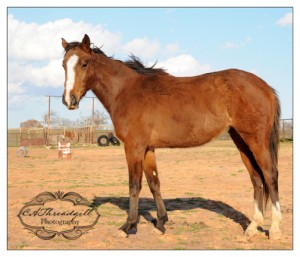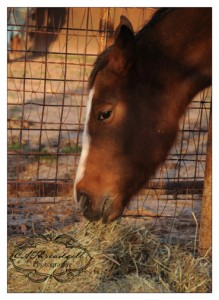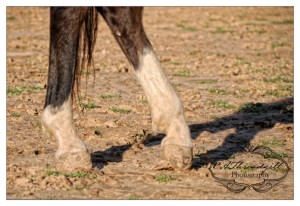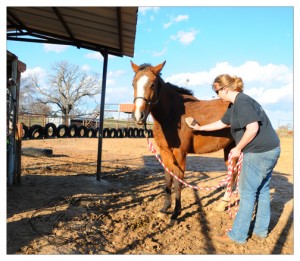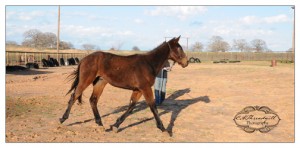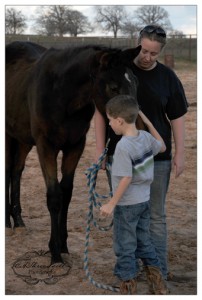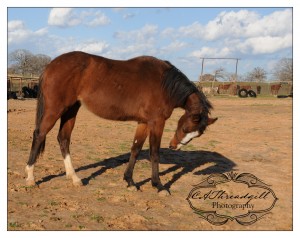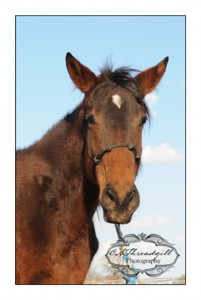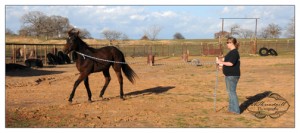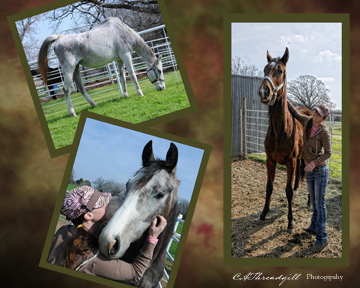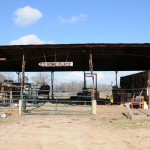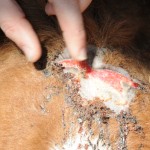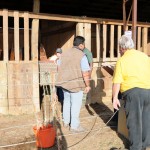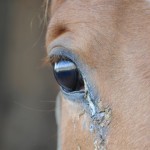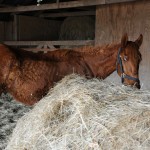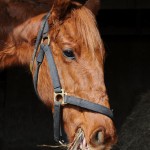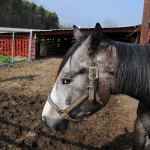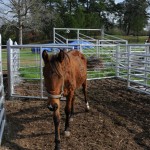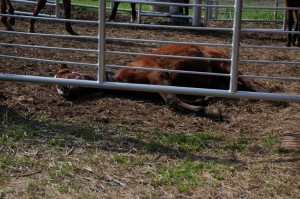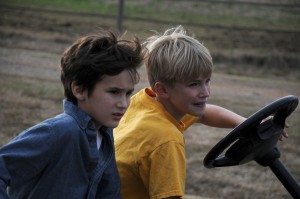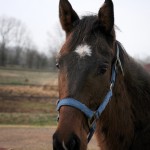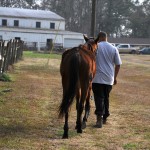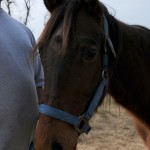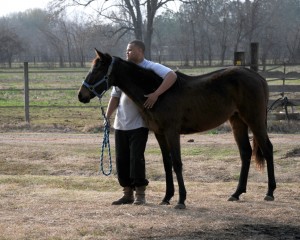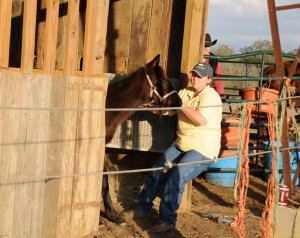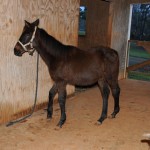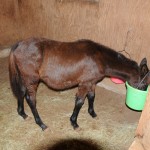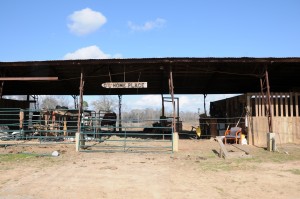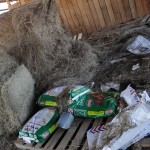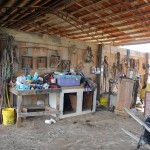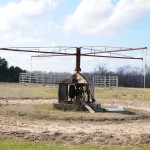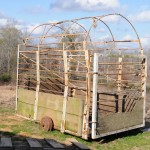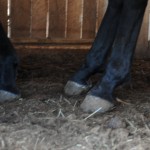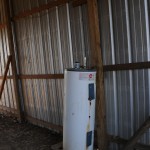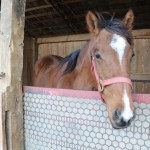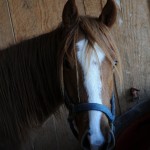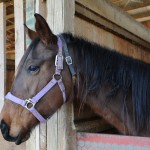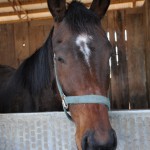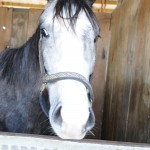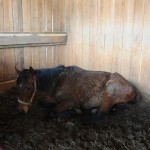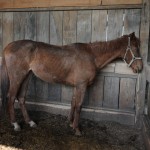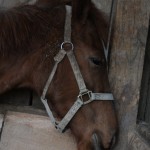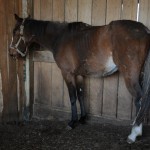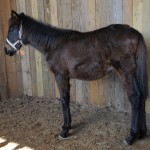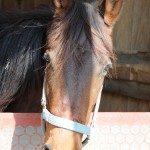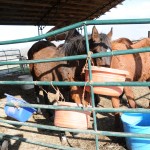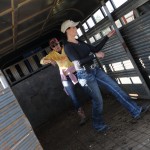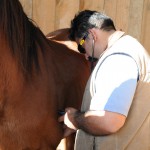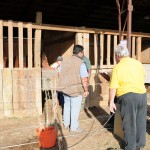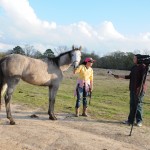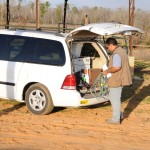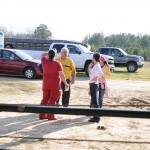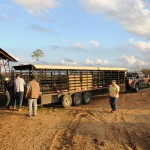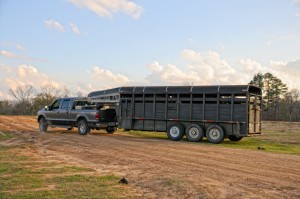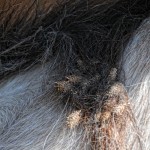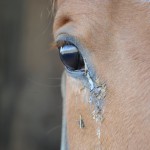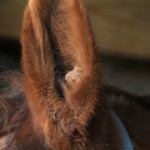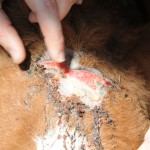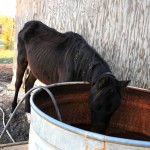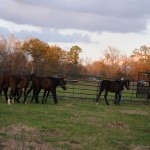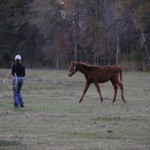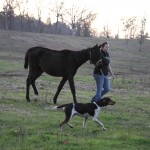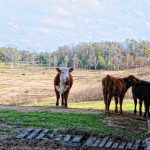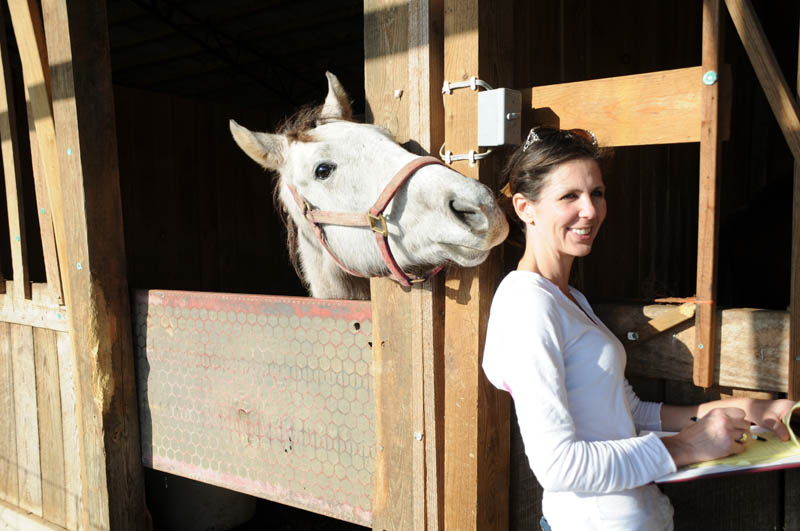Horse Seizure 1st Follow Up
The original report posted on facebook indicated that there were 60 horses that needed rescuing; in reality there were many more than sixty. Sixty-Eight horses were actually rescued, eight of whom have since passed away, despite the best efforts of those involved. The number of horses that died on the property, prior to the seizure, is not known for sure, but it is estimated that more than twenty horses died on the property. It was reported to me that there were two carcasses found by the volunteers upon arriving at the property and another five carcasses were located after the rescue ended. Twelve graves were also located. I have heard that during mid to late 2011 there may have been as many as 100 horses at the C and S Farm which is located onHillcrest Roadin Many, LA.
C and S Farm is owned by Charles and Suzanne Ford. They also owned or were the custodian of the horses, pigs, goats and dogs on the property. Mr. Ford’s daughter has posted on facebook that her parent’s requested the assistance of the Sabine Humane Society as early as November of 2011 and states “I also know she gave permition to come onto the properity and do what ever was need to be done.it just seems funny that no help was offered by your organization until the day before the tv stations came out. yes you offered hay that day and my father sent to get the hay the same evening it was offered by your organization. the horses were not hid by any means. most of the time the horses were next to the highway..”
Below are pictures that represent the view to C and S Farm from the highway.
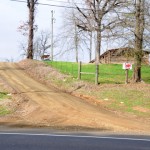


Mary Brocato, who in on the board of the Sabine Humane Society, was not at the rescue site on Saturday “since someone had stay at the shelter to answer the phones and help with the adoptions of the dogs and cat already there”. Ms. Brocato was on site on Sunday and when I decided to do a follow-up I called Ms. Brocate.
When I contact Ms. Brocato to ask “who made the first complaint” I was told that Mr. Ford’s wife Suzanne came in on November 11, 2011 and informed the Humane Society the Mr. Ford was not taking care of the horses that were on the farm. She asks that the Humane Society go out and check on the condition of the horses. Larry Kelly – Animal Cruelty Investigator of the Sabine Humane Society followed procedures and called Mr. Ford to inform him that a complaint had been filed and that the Humane Society would need to inspect the horses. Within two to three hours of this call Larry Kelly and Lisa went to the location that was reported to be where the horses were. Mr. Kelly and Lisa meet with Mr. Ford at the stable area and examined the horses in this area. The horses in the stalls did not appear to be in real bad condition and there was a small amount of hay in each of the stalls. Mr. Kelly informed Mr. Ford that the horses were not being feed enough and ask if any hay was needed. Mr. Ford said that he could use some assistance with hay and arrangements were made for Mr. Ford to pickup six rounds of hay. Mr. Ford picked up this hay later in the day. A couple of weeks later Mr. Ford was contacted again and informed that arrangements had been made for him to pick up an additional hay. Mr. Ford chooses not to pick up this hay. Mr. Ford also never mentioned that there were possibly 60 additional horses that were in need of care, he only showed the horses in the stable area which is down the dirt road and over a cattle guard.
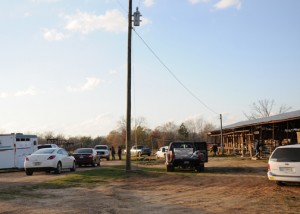
Ms. Brocato also told me that she had heard that prior to the seizure Mr. Ford had given a man down the road 8 horses and that a couple of people have come to the Humane Society and tried to claim some of the horses as theirs.
When I ask Ms. Brocato if she thought that all of the horses had been found on the acreage she told me that the Sabine Humane Society has spent the week searching the property. No additional horses have been found but they were catching pigs that have been running all over the place. I then ask about the cattle that had been on the property and Ms. Brocato told me that a Mr. Garland Peterson was claiming that the cattle were his and he was just grazing his cattle on the land.
Last week Ms. Brocato told me that she wants everyone to know that the Sabine Animal Shelter, run by the Sabine Humane Society has a small staff, Lisa Butler is the manager, Sarah Ritchie is the assistant manager and there are three inmates who work full time at the shelter. Larry Kelly is on the Board of Directors and is the Animal Cruelty Investigator; Willie Kinney works for the City ofManyand the Shelter and is the Animal Control Officer for the city. These individuals have worked diligently and long hours in coordinating the rescue, locating the horses’ papers, matching pictures and paper work and now caring for the nine horses still under their control and custody. Decisions were made, on Sunday, by the Humane Society as to who toke which horses. Ms. Brocato assured me that the Sabine Humane Society was very involved in the rescue and will remain involved and follow up on the well being of all of the horses rescued. On Saturday, January 21, 2012 Ms. Brocato informed me that the four horses which were still in the custody of the Humane Society would be transported to Remember Me Rescue either Monday or Tuesday.
When I ask Ms. Brocato about the donations the Sabine Humane Society had received for the Many Seizure she stated that they had received funds, goods and services. During our conversation she told me about, and then sent a FB message listing the following donations, Thom Basset of Providence, Rhode Island (cash donation), Nate Wagley of Many (cash donation), Candy Magee of Franklin Tennessee paid half of the feed and supply bill at Family Farm and Garden in Many, Family Farm and Garden discounted everything that “we” bought for the horse rescue effort (feed, wheelbarrow, padlocks, chains, feed buckets, water tanks,…just to mention a few things), Billy Henry of Lake Charles called and donated 22 round bales of hay, Jeremy Bowman from near Lufkin drove to Lake Charles, loaded the hay and drove it to Many at a discounted price, Bruce Taylor of Ft. Jessup donated and delivered three rolls of hay, Marion Hall and Shannon Clements-Hall donated sacks of feed and wormer. We’ve had donations ranging from $25 to $500 and even one for a $1,000. Bruce and Jan Tatum donated labor to clean barns and prepare stalls and paddock areas for horses and are fostering a colt. “The list goes on and on. These are only a few of the kind, generous people who have reached out to help these rescue horses and to help the shelter with limited resources and personnel.”
It is my understanding that the Sabine Humane Society and Animal Control no longer have any of the Many 60 in their actual possession. They will however continue to collect donations and supplies for the horses which remain in the Many andNatchitochesarea. Any donations clearly marked for the Many 60 will be used to assist and disbursed to these horses.
In speaking with other individuals, in the community, I was informed that there had been calls to the Humane Society, at least, one may have even been prior to Mrs. Ford visit to the Humane Society. I was also told that the Humane Society was told that there were “a lot of horses” on this property all prior to January of 2012.
The debate as to when the Sabine County Humane Society was first notified will probably go on for some time. There will be those that say the Humane Society did nothing until others got involved and those that say the Humane Society did not know the magnitude of the matter until January 2012. The bottom line is Mr. Ford, his family and trainer, William (Bill) Young knew and possibly others in the community knew. Is there anymore that could have been done prior to the seizure itself? I think there are additional steps that could have been taken and everyone needs to be prepared in case they are confronted with a similar issue.
If you follow the steps below you will make a difference:
1. Document what you see. Pictures speak volumes so if you have a camera, take some pictures, if the only camera you have is on your phone use that one. Make written notes of what you see and when you see it.
2. Find out who the Animal Cruelty Investigator is in your area and give them a call and accurately describe the abuse you are reporting. When you give your report be reasonably accurate, you do not want to appear to be inept.
3. If there is no action taken, follow-up with a letter detailing the abuse. It will be hard to do but keep emotions out of the letter. Also, you may want to mail the letter, certified return receipt, so you will have proof as to when you sent the letter.
4. Follow up again in a couple of days.
5. Ask your friends if they have seen the animal(s) in question. If they haven’t encourage them to go by and to then report their finding to the Animal Cruelty Investigator.
6. If you still don’t get any response, follow-up again, and remember to only state the facts as you know them.
7. If there is still no action taken and the Animal Cruelty Investigator hasn’t followed up you will need to get more aggressive by:
- Calling the police/sheriff’s department
- Post on facebook (post pictures if you have them)
- Contact your local television station and newspaper
8. If all else fails contact the nearest horse rescue organization and ask them to get involved. Some humane organization officers are mostly familiar with small domestic pets and they misdiagnose the horse’s problem and a horse rescue organization can educate the officer if necessary.
9. Get involved, stay involved and make some noise. Check on the animal as often as possible.
There are some things that you MUST NOT DO when you are confronted with this type of situation, and they are:
1. Do not enter the property where the animal(s) is located, you do not want to get arrested for trespassing.
2. Do not feed these animals; you do not want to be blamed on giving them something that made them sick.
3. Do not threaten anyone, just state the facts.
4. Do not personally remove the animal(s) in question.
I found an excellent article titled “When is it horse abuse?” This HorseAid article (www.igha.org/abuse.html) discusses the abuse and neglect of horses. It also shows how to determine if the horse is being abused or neglected. It is worth reading and bookmarking for future references.
There are other areas that need to be address and will be talked about in future follow-ups so check back.
Horse Seizure 3rd Follow Up
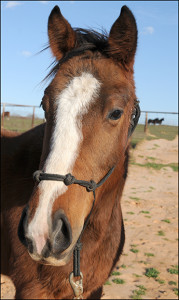 Hi y’all it is me …Lil’ Bit, in Alvord, Texas. I know, I know, it has been a while since you guys have heard from me, but you see I have been so busy these past couple of months that I haven’t had time to stay in touch. Now where should I start, there have been so many things going on….
Hi y’all it is me …Lil’ Bit, in Alvord, Texas. I know, I know, it has been a while since you guys have heard from me, but you see I have been so busy these past couple of months that I haven’t had time to stay in touch. Now where should I start, there have been so many things going on….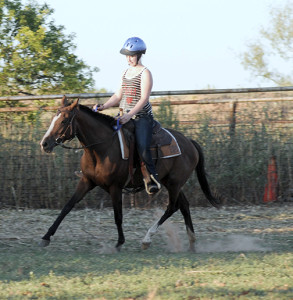 Do you remember when I told you that Mom kept talking about being broke, well I found out that it had nothing to do with being hurt and it had nothing to do with being out of money. All they wanted to do was to put this thing called a saddle on me and then they climb on top and ask me to walk around and sometimes they even want me to run. Trust me we have had discussions about running in this Texas heat and I’ll do it for a minute, just so they can see that I know what they want.
Do you remember when I told you that Mom kept talking about being broke, well I found out that it had nothing to do with being hurt and it had nothing to do with being out of money. All they wanted to do was to put this thing called a saddle on me and then they climb on top and ask me to walk around and sometimes they even want me to run. Trust me we have had discussions about running in this Texas heat and I’ll do it for a minute, just so they can see that I know what they want.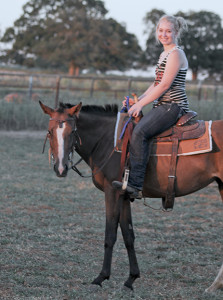 Oh, oh, oh, remember my friend Lilly from Remember Me Rescue, well she came by again yesterday, to check up on me and Ransom and the lady with the camera came by also. The lady with the camera wanted me to put my ears up and after a while I gave in and put them put. You should have seen what Grandma was doing trying to get me to put my ears up, it was funny, but I pretended to ignore her. Unfortunately I don’t think that we will be seeing any pictures of that.
Oh, oh, oh, remember my friend Lilly from Remember Me Rescue, well she came by again yesterday, to check up on me and Ransom and the lady with the camera came by also. The lady with the camera wanted me to put my ears up and after a while I gave in and put them put. You should have seen what Grandma was doing trying to get me to put my ears up, it was funny, but I pretended to ignore her. Unfortunately I don’t think that we will be seeing any pictures of that. Do you want to know a secret…..? Ransom has a GIRLFRIEND!!!! That’s right he has a girlfriend and I think it may be a little serious. I keep telling him though that he needs to start working harder or else she will fall in love with me and everything that I can do. But I think we both need to watch out for Kipper, I mean he has these barrel things down pat.
Do you want to know a secret…..? Ransom has a GIRLFRIEND!!!! That’s right he has a girlfriend and I think it may be a little serious. I keep telling him though that he needs to start working harder or else she will fall in love with me and everything that I can do. But I think we both need to watch out for Kipper, I mean he has these barrel things down pat.
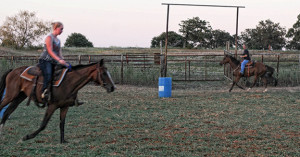
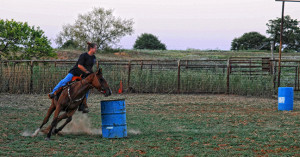
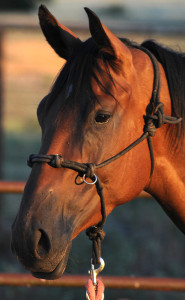
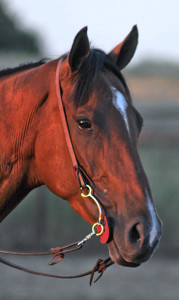
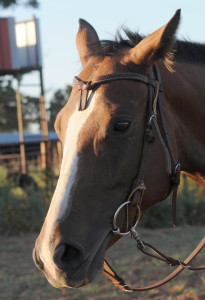
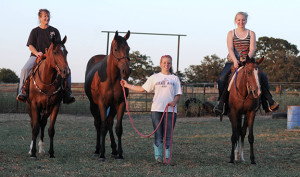
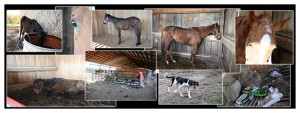
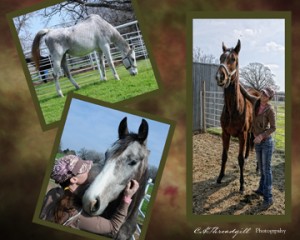
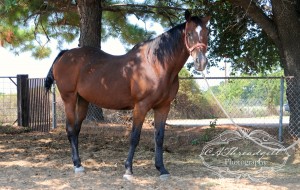
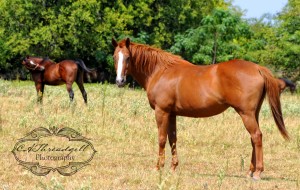
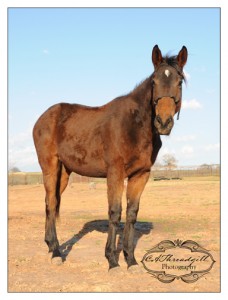 It is hard to write this follow-up because it turned out that this was not the isolated incident I thought it was, but it was the first one where I was on the scene. During the past twelve months I have learned so much about the Race Horse Industry, and yes it is an industry. I have received a number of calls and e-mails regarding other race horses being neglected and found that it is almost impossible for individuals or rescue groups to take action. If the owner doesn’t relinquish the horses voluntarily then there must be such a public outcry before anything gets done. I have received pictures of dead and dying horses, have called police departments, sheriff departments, neighboring farms all the time giving the owner the opportunity to remove evidence of abuse and neglect. There are inspectors and horse racing officials who know about these incidences but the abuse continues.
It is hard to write this follow-up because it turned out that this was not the isolated incident I thought it was, but it was the first one where I was on the scene. During the past twelve months I have learned so much about the Race Horse Industry, and yes it is an industry. I have received a number of calls and e-mails regarding other race horses being neglected and found that it is almost impossible for individuals or rescue groups to take action. If the owner doesn’t relinquish the horses voluntarily then there must be such a public outcry before anything gets done. I have received pictures of dead and dying horses, have called police departments, sheriff departments, neighboring farms all the time giving the owner the opportunity to remove evidence of abuse and neglect. There are inspectors and horse racing officials who know about these incidences but the abuse continues.